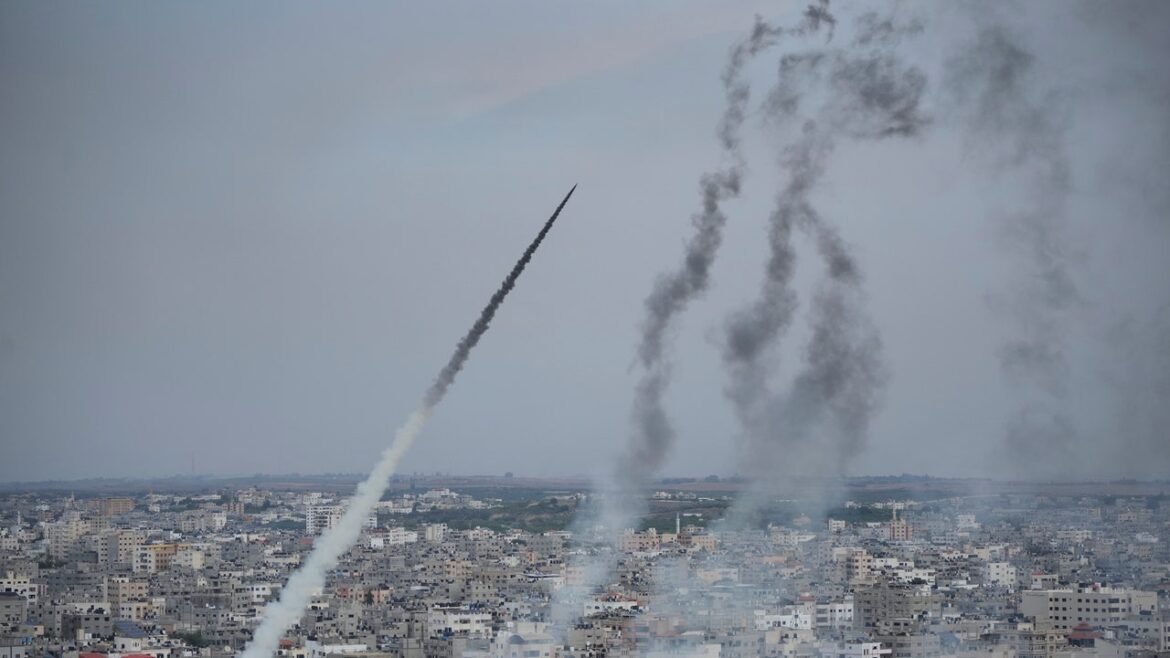At seven this morning, our son and daughter waded into our bedroom, a sleepy Saturday in Tel Aviv, the tail end of the long Sukkot holiday. We all snuggled together in bed, bleary-eyed. The kids started a game that soon turned into low-grade squabble, when, suddenly, an air-raid siren blared. We ducked into our building’s stairwell, our “safe space” for lack of any other in this old area of the city. Some neighbors were already there, in their pajamas, everyone smiling at one another awkwardly. We spoke of previous rounds of rocket fire, all of which had been intercepted by the Israeli military to a high degree, so panic was not in the air; even the kids were acting blasé. But then we opened our phones.
Surreal sights and early reports from around the country began to trickle in: Israeli vehicles had been taken over by Palestinian militants, and were barrelling through southern Israeli cities; ski-masked terrorists were shooting indiscriminately at oncoming cars and into homes in Israeli towns. Several gunmen were seen paragliding across the border, and there were news reports that an Israeli military base had been commandeered by Hamas. Friends posted about their relatives living in kibbutzim on the Gaza border whose homes had been raided while they were huddled inside with small children, pleading for help. Images emerged purporting to show four Israeli men, stripped down to their underwear on a sidewalk of an unspecified southern city, militants standing next to them, holding rifles over the Israelis’ heads. The coming hours and days will tell us the details, the facts, the numbers—but the fear is immediate.
According to the Israeli military, more than two thousand rockets have been fired from the Gaza Strip since early this morning. At least one hundred Israelis have been reported killed. More than nine hundred injured Israelis have been hospitalized, some critically—but those numbers are expected to rise. The health ministry in Gaza, which is run by Hamas, reported that a hundred and ninety-eight Palestinians had been killed in the hours since the escalation began. As I’m writing this, dozens of militants are still storming through the streets of Israel. Palestinian gunmen continue to infiltrate Israel’s border fence with Gaza, which is now effectively breached, including by bulldozer. At least twelve communities around the country are still under siege, according to Israel’s Channel 12. Footage has been released of senior Hamas leaders gathered together in a room, wearing suits, intently watching the images of war on a television screen, clearly content.
Some five hours after the morning’s events began, Israel declared a state of war.
“Citizens of Israel, we are at war,” Prime Minister Benjamin Netanyahu said, in a video message recorded in Tel Aviv. “Not an operation, not a round [of fighting] but at war. This morning Hamas initiated a murderous surprise attack against the state of Israel and its citizens.” Yoav Gallant, the defense minister, said: “Hamas made a grave mistake this morning and started a war against the State of Israel. I.D.F. soldiers are fighting the enemy at all the infiltration sites.” Gallant also approved a wide-scale call-up of military reservists for service. Among them is my nephew, whose mother—my older sister—was just then busy uninstalling Giacomettis from the walls of the Tel Aviv Museum of Art, where she works, for safekeeping amid the rocket fire.
Sooner or later, there will be the inevitable discussion about how Hamas was able to launch such a devastating surprise attack, which comes exactly fifty years after Israel was caught flat-footed in what became known as the Yom Kippur War. There will also be time to note the cost of the Israeli occupation: the military’s resources are overwhelmingly devoted to patrolling and guarding the occupied West Bank, at the expense of the country’s vulnerable southern communities. But it cannot be a coincidence that this operation was launched as Israel has been experiencing its worst civic conflict in years, with the government’s campaign to overhaul the judiciary—attempts that have been met with weekly mass demonstrations and public fury. Military reservists, who had been among the fiercest critics of the government’s actions, today called on Israelis to unite and report for service. The leaders of the protest movement swiftly declared that tonight’s planned protests—for the fortieth week—have been cancelled.
But the story that is emerging as perhaps the most worrying of all is the murkiness of the hostage situation. There were unverified reports from Hamas that about thirty-five Israelis, soldiers and civilians, have been taken hostage. Again, this is unverified: one must assume that a misinformation campaign is under way. Still, Israel has not dealt with violence this grave since the second intifada, two decades ago; any country will be greatly tested under such circumstances. The spectre of hostages is especially grave. In 2011, an Israeli soldier, Gilad Shalit, was released after five years in Hamas captivity in exchange for more than a thousand prisoners, primarily Palestinians. Three years later, a controversial Israeli-military directive on the prevention of hostage-taking received new scrutiny. It’s still too early—and too devastating—to know the picture that will emerge from this coördinated attack. In Israel, there is already talk about this being the beginning of a protracted “Sukkot War.” ♦



